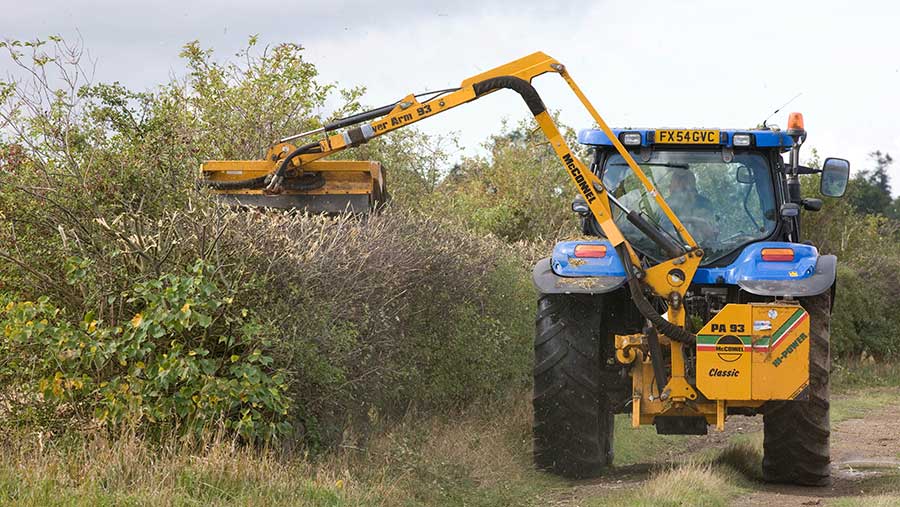Top tips on staying legal when removing hedges
 © Tim Scrivener
© Tim Scrivener The rules around hedgerows can be complex with permissions on what you can do to them changing, depending on the season, their location and even their length.
Removing a hedgerow is a criminal offence which can lead to potentially unlimited fines if the breach is deemed serious enough to be heard in the Crown Court.
We’ve pulled together everything you need to know before making alterations, but, remember, if in doubt, seek advice first.
See also: Handy guide to key cross-compliance dates 2019
What hedgerow legislation do I need to know about?
In England and Wales, the 1997 Hedgerows Regulations made it against the law to remove or destroy certain hedgerows without permission from the local planning authority.
The regulations do not apply in Scotland and Northern Ireland, but farmers are still required to protect hedgerows as a habitat for nesting birds.
The Wildlife and Countryside Act 1981 prohibits damage to the nest of any wild bird, while that nest is in use or being built, which effectively makes the removal or trimming of a hedgerow an offence in the nesting season.
What are the penalties for breaking the regulations?
Breaking the rules is a criminal offence and can attract fines of up to £5,000 in a Magistrates Court. If a case ended up in the Crown Court, then the fine could be unlimited.
If you remove an important hedgerow without permission, you may also be forced to reinstate it.
Remind me when can I cut and trim hedgerows?
Under the rules of the Basic Payment Scheme, farmers must generally not cut or trim any hedge between 1 March and 31 August. This rule applies in all four regions of the UK.
However, there are some exceptions to the closed period for hedge-cutting – for example, where health and safety could be an issue because the hedge is on a roadside.
Farmers in some regions may also be able to apply to trim hedges from 1 August, but only where they are drilling oilseed rape or grass and written permission must be granted before any trimming takes place.
Are all hedges covered by the Hedgerow Regulations?
It is against the law to remove most countryside hedges without first seeking permission.
The Hedgerow Regulations protect hedges which meet the right criteria on age, location and length.
Important hedges are any hedgerow more than 30 years old that are valuable because of the mix of species they contain, or because they have historic significance.
Examples of the criteria used to define whether a hedge is important include the number of species it contains or whether the hedge marks a parish or estate boundary.
Protected hedges are also those growing in, or next to, any common land or protected land, such as local nature reserves and SSSIs (Site of Special Scientific Interest).
Hedges are also protected if they grow in, or next, to land used for farming, forestry or horses with a continuous length of 20m or more; or with a continuous length of less than 20m but meets another hedge at each end.
If there are gaps of 20m or less within a hedgerow, these are to be counted as part of the hedge. If the gap is more than 20m wide, you are dealing with separate hedges.
Are any hedges exempt?
The regulations do not apply to hedgerows within the curtilage, or marking a boundary, of a house.
It is not necessary to apply for a hedge to be removed if it is less than 20m long, is not part of a 20m length and does not meet another hedge at either end.
There is also an exemption which allows a new opening to be made in a hedge line to replace existing access to the land (but the previous access gap must be filled by planting a hedge within eight months of making the new opening).
Other exemptions include:
- Where correctly managing the hedgerow by laying or coppicing
- Where there’s no other cost-effective way of accessing the land
- A temporary access point for emergency purposes is required
- The land is needed for national defence purposes
- Where carrying out work which has planning permission
- To eradicate or prevent disease or tree pests by law, for example a plant health (forestry) order
- To prevent interference with, or damage to, electric power lines and apparatus
- To complete legally permitted drainage or flood defence works
- New trunk roads or motorways are being built on the site
I’ve got a hedge I would like to remove. Can I?
Anybody wishing to remove or destroy a hedge covered by the Hedgerow Regulations must apply to their local planning authority for permission (or if in the National Parks or Broads Authority areas to their offices).
The planning authority has 42 days to make a decision and can either issue a Hedgerow Removal Notice or a Hedgerow Retention Notice (issued if the hedge is important and should be retained). Hedgerow Removal Notices are only normally valid for two years after their issue.
If no response comes from the LPA within 42 days then the hedgerow can be removed.
Where are the best sources of further information?
The rules on hedgerow management are set out in the cross-compliance guidance notes for each of the devolved regions.
Read Defra’s latest guidance on the protection and management of countryside hedgerows.
